Arturo Laurenzi
A High-Force Gripper with Embedded Multimodal Sensing for Powerful and Perception Driven Grasping
Apr 07, 2025Abstract:Modern humanoid robots have shown their promising potential for executing various tasks involving the grasping and manipulation of objects using their end-effectors. Nevertheless, in the most of the cases, the grasping and manipulation actions involve low to moderate payload and interaction forces. This is due to limitations often presented by the end-effectors, which can not match their arm-reachable payload, and hence limit the payload that can be grasped and manipulated. In addition, grippers usually do not embed adequate perception in their hardware, and grasping actions are mainly driven by perception sensors installed in the rest of the robot body, frequently affected by occlusions due to the arm motions during the execution of the grasping and manipulation tasks. To address the above, we developed a modular high grasping force gripper equipped with embedded multi-modal perception functionalities. The proposed gripper can generate a grasping force of 110 N in a compact implementation. The high grasping force capability is combined with embedded multi-modal sensing, which includes an eye-in-hand camera, a Time-of-Flight (ToF) distance sensor, an Inertial Measurement Unit (IMU) and an omnidirectional microphone, permitting the implementation of perception-driven grasping functionalities. We extensively evaluated the grasping force capacity of the gripper by introducing novel payload evaluation metrics that are a function of the robot arm's dynamic motion and gripper thermal states. We also evaluated the embedded multi-modal sensing by performing perception-guided enhanced grasping operations.
* 8 pages, 15 figures
CONCERT: a Modular Reconfigurable Robot for Construction
Apr 07, 2025Abstract:This paper presents CONCERT, a fully reconfigurable modular collaborative robot (cobot) for multiple on-site operations in a construction site. CONCERT has been designed to support human activities in construction sites by leveraging two main characteristics: high-power density motors and modularity. In this way, the robot is able to perform a wide range of highly demanding tasks by acting as a co-worker of the human operator or by autonomously executing them following user instructions. Most of its versatility comes from the possibility of rapidly changing its kinematic structure by adding or removing passive or active modules. In this way, the robot can be set up in a vast set of morphologies, consequently changing its workspace and capabilities depending on the task to be executed. In the same way, distal end-effectors can be replaced for the execution of different operations. This paper also includes a full description of the software pipeline employed to automatically discover and deploy the robot morphology. Specifically, depending on the modules installed, the robot updates the kinematic, dynamic, and geometric parameters, taking into account the information embedded in each module. In this way, we demonstrate how the robot can be fully reassembled and made operational in less than ten minutes. We validated the CONCERT robot across different use cases, including drilling, sanding, plastering, and collaborative transportation with obstacle avoidance, all performed in a real construction site scenario. We demonstrated the robot's adaptivity and performance in multiple scenarios characterized by different requirements in terms of power and workspace. CONCERT has been designed and built by the Humanoid and Human-Centered Mechatronics Laboratory (HHCM) at the Istituto Italiano di Tecnologia in the context of the European Project Horizon 2020 CONCERT.
Autonomous Behavior Planning For Humanoid Loco-manipulation Through Grounded Language Model
Aug 15, 2024


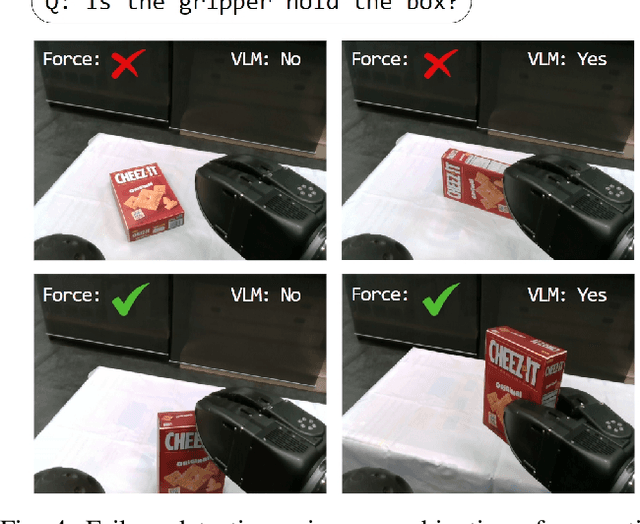
Abstract:Enabling humanoid robots to perform autonomously loco-manipulation in unstructured environments is crucial and highly challenging for achieving embodied intelligence. This involves robots being able to plan their actions and behaviors in long-horizon tasks while using multi-modality to perceive deviations between task execution and high-level planning. Recently, large language models (LLMs) have demonstrated powerful planning and reasoning capabilities for comprehension and processing of semantic information through robot control tasks, as well as the usability of analytical judgment and decision-making for multi-modal inputs. To leverage the power of LLMs towards humanoid loco-manipulation, we propose a novel language-model based framework that enables robots to autonomously plan behaviors and low-level execution under given textual instructions, while observing and correcting failures that may occur during task execution. To systematically evaluate this framework in grounding LLMs, we created the robot 'action' and 'sensing' behavior library for task planning, and conducted mobile manipulation tasks and experiments in both simulated and real environments using the CENTAURO robot, and verified the effectiveness and application of this approach in robotic tasks with autonomous behavioral planning.
Whole-body MPC for highly redundant legged manipulators: experimental evaluation with a 37 DoF dual-arm quadruped
Oct 04, 2023



Abstract:Recent progress in legged locomotion has rendered quadruped manipulators a promising solution for performing tasks that require both mobility and manipulation (loco-manipulation). In the real world, task specifications and/or environment constraints may require the quadruped manipulator to be equipped with high redundancy as well as whole-body motion coordination capabilities. This work presents an experimental evaluation of a whole-body Model Predictive Control (MPC) framework achieving real-time performance on a dual-arm quadruped platform consisting of 37 actuated joints. To the best of our knowledge this is the legged manipulator with the highest number of joints to be controlled with real-time whole-body MPC so far. The computational efficiency of the MPC while considering the full robot kinematics and the centroidal dynamics model builds upon an open-source DDP-variant solver and a state-of-the-art optimal control problem formulation. Differently from previous works on quadruped manipulators, the MPC is directly interfaced with the low-level joint impedance controllers without the need of designing an instantaneous whole-body controller. The feasibility on the real hardware is showcased using the CENTAURO platform for the challenging task of picking a heavy object from the ground. Dynamic stepping (trotting) is also showcased for first time with this robot. The results highlight the potential of replanning with whole-body information in a predictive control loop.
Design and Validation of a Multi-Arm Relocatable Manipulator for Space Applications
Jan 24, 2023



Abstract:This work presents the computational design and validation of the Multi-Arm Relocatable Manipulator (MARM), a three-limb robot for space applications, with particular reference to the MIRROR (i.e., the Multi-arm Installation Robot for Readying ORUs and Reflectors) use-case scenario as proposed by the European Space Agency. A holistic computational design and validation pipeline is proposed, with the aim of comparing different limb designs, as well as ensuring that valid limb candidates enable MARM to perform the complex loco-manipulation tasks required. Motivated by the task complexity in terms of kinematic reachability, (self)-collision avoidance, contact wrench limits, and motor torque limits affecting Earth experiments, this work leverages on multiple state-of-art planning and control approaches to aid the robot design and validation. These include sampling-based planning on manifolds, non-linear trajectory optimization, and quadratic programs for inverse dynamics computations with constraints. Finally, we present the attained MARM design and conduct preliminary tests for hardware validation through a set of lab experiments.
Trajectory Optimization for Quadruped Mobile Manipulators that Carry Heavy Payload
Oct 13, 2022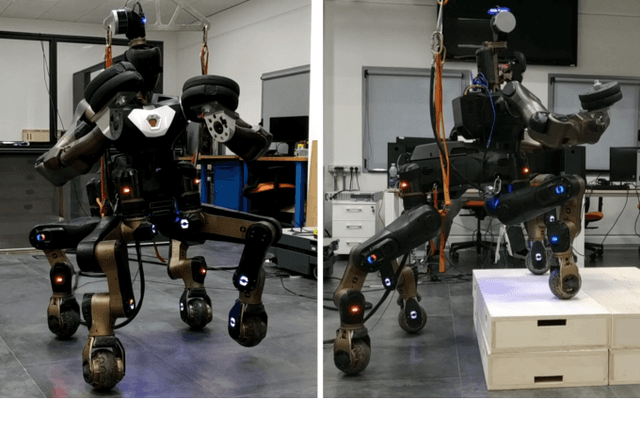



Abstract:This paper presents a simplified model-based trajectory optimization (TO) formulation for motion planning on quadruped mobile manipulators that carry heavy payload of known mass. The proposed payload-aware formulation simultaneously plans locomotion, payload manipulation and considers both robot and payload model dynamics while remaining computationally efficient. At the presence of heavy payload, the approach exhibits reduced leg outstretching (thus increased manipulability) in kinematically demanding motions due to the contribution of payload manipulation in the optimization. The framework's computational efficiency and performance is validated through a number of simulation and experimental studies with the bi-manual quadruped CENTAURO robot carrying on its arms a payload that exceeds 15 % of its mass and traversing non-flat terrain.
Prototyping fast and agile motions for legged robots with Horizon
Jun 17, 2022


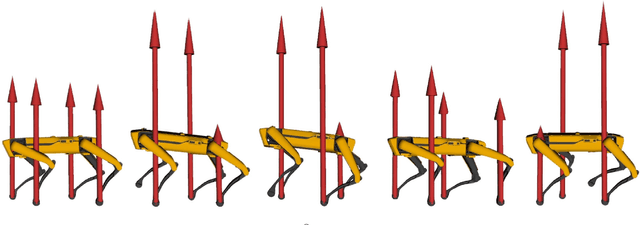
Abstract:For legged robots to perform agile, highly dynamic and contact-rich motions, whole-body trajectories computation of under-actuated complex systems subject to non-linear dynamics is required. In this work, we present hands-on applications of Horizon, a novel open-source framework for trajectory optimization tailored to robotic systems, that provides a collection of tools to simplify dynamic motion generation. Horizon was tested on a broad range of behaviours involving several robotic platforms: we introduce its building blocks and describe the complete procedure to generate three complex motions using its intuitive and straightforward API.
Loco-Manipulation Planning for Legged Robots: Offline and Online Strategies
May 20, 2022



Abstract:The deployment of robots within realistic environments requires the capability to plan and refine the loco-manipulation trajectories on the fly to avoid unexpected interactions with a dynamic environment. This extended abstract provides a pipeline to offline plan a configuration space global trajectory based on a randomized strategy, and to online locally refine it depending on any change of the dynamic environment and the robot state. The offline planner directly plans in the contact space, and additionally seeks for whole-body feasible configurations compliant with the sampled contact states. The planned trajectory, made by a discrete set of contacts and configurations, can be seen as a graph and it can be online refined during the execution of the global trajectory. The online refinement is carried out by a graph optimization planner exploiting visual information. It locally acts on the global initial plan to account for possible changes in the environment. While the offline planner is a concluded work, tested on the humanoid COMAN+, the online local planner is still a work-in-progress which has been tested on a reduced model of the CENTAURO robot to avoid dynamic and static obstacles interfering with a wheeled motion task. Both the COMAN+ and the CENTAURO robots have been designed at the Italian Institute of Technology (IIT).
Optimization-Based Quadrupedal Hybrid Wheeled-Legged Locomotion
Jul 15, 2021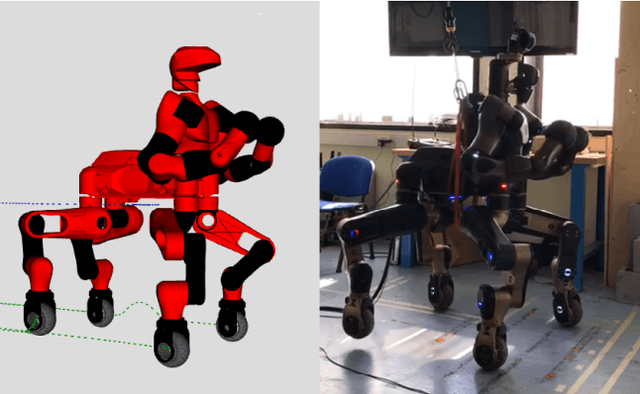
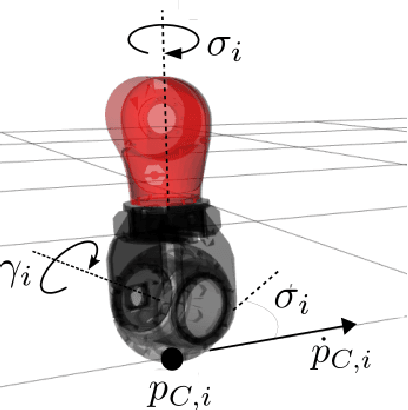
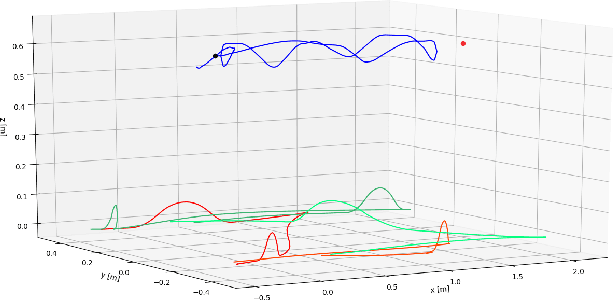
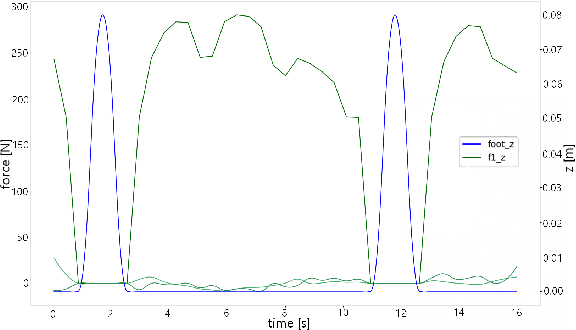
Abstract:Hybrid wheeled-legged locomotion is a navigation paradigm only recently opened up by novel robotic designs,e.g. the centaur-type humanoid CENTAURO [1] or the quadruped ANYmal [2] in its configuration featuring non-steerable wheels. The term Hybrid Locomotion is hereafter used to indicate a particular type of locomotion, achieved with simultaneous and coordinate use of legs and wheels,see Fig. 1. Such choice stems at the intersection between legged locomotion and the simpler wheeled navigation, in order to get the best from both techniques: agility and ability to traverse uneven terrains from the first, speed and stability from the second. As a consequence, the problem of planning feasible trajectories for a hybrid robot shares many similarities with the legged locomotion problem: also in the hybrid case the motion of the base is reached through contact of the feet with the environment, taking into account that the wheeled feet can just push on the ground and not pull it. Forces compatible with friction cones have to be considered, while the contacts can slide just along the direction prescribed by the orientation of the wheels.
Agile Actions with a Centaur-Type Humanoid: A Decoupled Approach
Mar 12, 2021
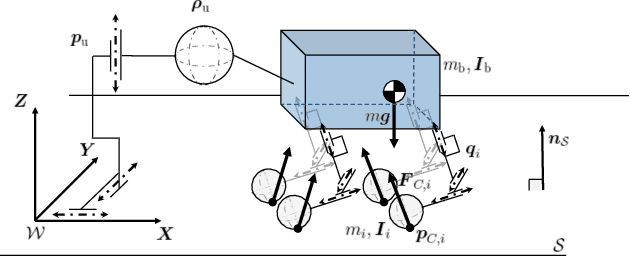
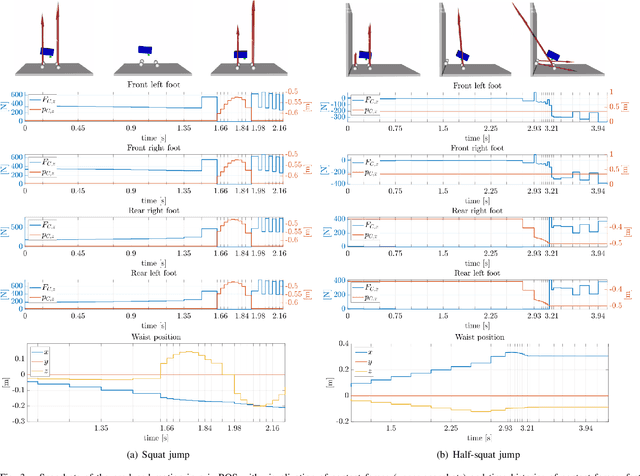
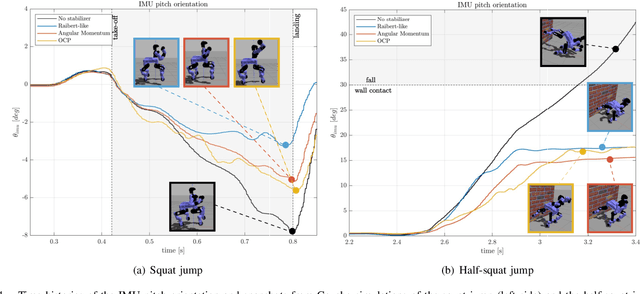
Abstract:The kinematic features of a centaur-type humanoid platform, combined with a powerful actuation, enable the experimentation of a variety of agile and dynamic motions. However, the higher number of degrees-of-freedom and the increased weight of the system, compared to the bipedal and quadrupedal counterparts, pose significant research challenges in terms of computational load and real implementation. To this end, this work presents a control architecture to perform agile actions, conceived for torque-controlled platforms, which decouples for computational purposes offline optimal control planning of lower-body primitives, based on a template kinematic model, and online control of the upper-body motion to maintain balance. Three stabilizing strategies are presented, whose performance is compared in two types of simulated jumps, while experimental validation is performed on a half-squat jump using the CENTAURO robot.
 Add to Chrome
Add to Chrome Add to Firefox
Add to Firefox Add to Edge
Add to Edge